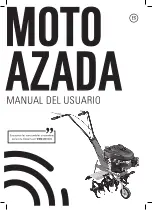
21
3.
Clean around the oil dipstick or oil fill
tube (whichever applies) to prevent dirt
from falling into the crankcase.
4.
On engines with an oil fill tube, remove
the fill cap and add oil (if required) until it
reaches the top of the fill tube. Reinstall
the fill cap.
5.
On engines with a dipstick, remove it
and wipe it clean. Reinsert the dipstick,
tighten it securely, and remove it. Add oil
as needed to bring the level up to the FULL
mark. Wipe dipstick clean each time oil
level is checked. Do not overfill. Tighten
dipstick securely.
B. To Change the Engine Oil:
Change the engine oil as instructed in the
Engine Owner’s Manual.
SPARK PLUG SERVICE
Inspect and clean or replace the spark plug
after every 100 operating hours or annual-
ly. Refer to the Engine Owner’s Manual for
spark plug service instructions.
In some areas, local law requires using re-
sistor spark plugs to suppress ignition sig-
nals. If the engine was originally equipped
with a resistor spark plug, use the same
type for replacement.
SPARK ARRESTER SCREEN
SERVICE
If the engine muffler is equipped with a
spark arrester screen, remove and clean it
according to the service intervals and in-
structions in the Engine Owner’s Manual.
THROTTLE LEVER ADJUSTMENT
If the engine does not respond to various
throttle lever settings, refer to the Engine
Owner’s Manual for service information or
contact your local authorized engine deal-
er.
WARNING:
Operators
shall not tamper with the engine
governor settings on the
machine; the governor controls
the maximum safe operating
speed to protect the engine and
all moving parts from damage
caused by overspeed.
Authorized service shall be
sought if a problem exists.
CARBURETOR/GOVERNOR
CONTROL ADJUSTMENTS
The carburetor was adjusted at the factory
for best operating speed. Refer to the En-
gine Owner’s Manual for any adjustment
information or see your authorized engine
dealer.
The governor controls the maximum safe
operating speed and protects the engine
and all moving parts from damage caused
by overspeeding. Do not tamper with the
engine governor settings.
OFF-SEASON STORAGE
When the tiller won’t be used for an ex-
tended period, prepare it for storage as fol-
lows:
1.
Clean the tiller and engine.
2.
Do routine tiller lubrication and check
for loose parts and hardware.
3.
Protect the engine and perform recom-
mended engine maintenance by following
the storage instructions found in the En-
gine Owner’s Manual. Be sure to protect
the fuel lines, carburetor and fuel tank
from gum deposits by removing fuel or by
treating fuel with a fuel stabilizer (follow
engine manufacturer’s recommendations).
4.
Store unit in a clean, dry area.
5.
Never store the tiller with fuel in the fuel
tank in an enclosed area where gas fumes
could reach an open flame or spark, or
where ignition sources are present (space
heaters, hot water heaters, furnaces, etc.).
WARNING:
Before inspecting, cleaning or servicing the machine, shut off engine, wait for all
moving parts to come to a complete stop, disconnect spark plug wire and move wire away from
spark plug. Failure to follow these instructions can result in serious personal injury or property
damage.












































